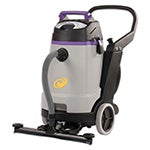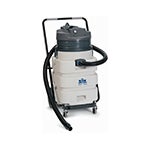Overview:
Commercial wet dry vacuums are a useful tool for cleaning up spills and various types of debris in shop-type environments. Some units have 2 tanks that separate wet and dry components and some have a single tank where they combine everything.
When comparing wet-dry vacuums, it is important to consider the size of the tank along with air watt or airwatt rating. The size of the tanks can range from 2-20 gallons. Two to five gallons is generally sufficient for a smaller area/task. Six to twelve gallons is good for a medium area/task, and fourteen to twenty gallons is preferred for larger areas/tasks. The airwatt rating is a ratio of the airflow and water lift. The airflow and water lift are measured in cubic feet per minute (CFM) and inches of water (inH2O) respectively. Manufacturers use CFM to convey the strength of a vacuum, a higher CFM will move more air through the unit at a faster rate than a lower CFM unit. Water lift, also known as static pressure refers to the suction force. Airwatts can be expressed in the following formula:
(CFM x inH2O)/8.5 = Airwatt Rating
A commercial wet dry vacuum should have about 1000 airwatts in order to achieve a desirable cleaning outcome.
Decision-makers should review the following considerations.
- Space: Area(s) where the vacuum will be used. Is the unit appropriate for the size of the space and will there be obstacles or furniture to navigate?
- Surfaces/Application: Type of surface(s) the wet/dry vacuum will be used on. What material(s) will the unit be used on? Is the tank sufficient for the volume of material? Is the motor powerful enough to take care of the type of debris?
- Users: The physical characteristics of the end-users. Is the unit adaptable to be used by different height users?
- Storage: The units will need to be stored somewhere. Is there storage space in an existing custodial closet?
- Portability: The ease by which a user can get the equipment to the job site. Is there elevator access? If not, is it easy to get the unit up and down stairs?
- Maintenance: Ease of changing filters/bags. Is a special tool needed for regular field and daily maintenance?
- Power: Access to power. Units can be corded or battery-powered. Are there outlets available? Is the cord long enough? Is the battery capable of lasting the entire shift/task on a single charge?
- Noise and Vibration: Are noise or vibration an issue where the unit will be used? Are equipment operators exposed to hand-arm or whole body vibration?
- Testing and Feedback: Demo the product. What was the users’ feedback on the unit after trying in the work environment?
Wet/Dry Vacuums
|
ProTeam
|
Karcher
|
Criteria Rating |
★★★★☆ |
★★☆☆☆ |
Photo |

|

|
Review |
Large capacity strong suction. Large capacity tank and extremely strong suction. Front-mounted squeegee helps with water pick up. The attached wand is curved to promote neutral upper extremities. The unit comes with various attachments. |
Strong suction and large capacity. Strong suction and large tank capacity. Optional front-mounted squeegee to help facilitate water pick up. Optional curved wand. The unit does not have a HEPA filter. |
UC Supplier |
Waxie | Waxie |
Specs |
CFM: 105 Water Lift: 95" Airwatt: 1,174 Motor: 1380 W Weight: 68 lbs Cord: 50' Charge time: NA Decibel: 69 dBA Cleaning Path: 14" Solution/Recovery Tank: 15 gal HEPA Filter: Yes Curved Wand: Yes ♠ |
CFM: 101 Water Lift: 87" Airwatt: 1,034 Motor: 2 stage 1.5 hp Weight: 55 lbs Cord: 27' Charge time: NA Decibel: 69 dBa Cleaning Path: 16" Solution/Recovery Tank: 20 gal HEPA Filter: No Curved Wand: Yes ♠ |
Resources |
Titan Website |
Products are rated on a 5-star scale based on the Criteria Rating - ★
The product specification exceeds minimum UC Criteria - ♠
The product does not meet minimum UC Criteria - ⚠
